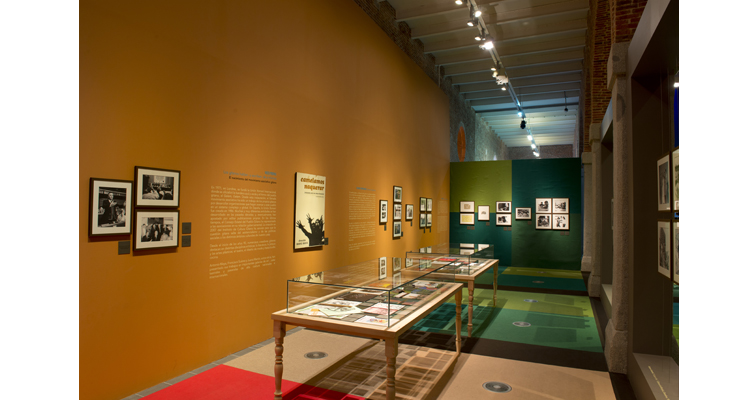


En 1971, en Londres, se fundó la Unión Romaní Internacional, donde se oficializó la bandera azul y verde y el himno del pueblo gitano, el Gelem, Gelem.s Desde esta instauración, el llamado movimiento asociativo ha sido un trabajo de los propios gitanos por desarrollar organizaciones que hagan avanzar a este pueblo en un sistema complejo y global. En España, la Unión Romaní fue creada en 1986. Muchas y muy diferentes entidades se han desarrollado en las pasadas décadas, y, eventualmente, han apostado por editar publicaciones propias. En los últimos tiempos, el Consejo Estatal del Pueblo Gitano ha representado a las asociaciones en su relación gubernamental. La creación en 2007 del Instituto de Cultura Gitana ha servido para que la cuestión gitana salte del asistencialismo y de las políticas sociales a los distintos ámbitos culturales de nuestro país.
Desde el inicio de los años 90, numerosos creadores gitanos destacan en distintas disciplinas artísticas: la literatura, la pintura y las artes plásticas; el teatro, el diseño de moda y hasta la alta cocina.
Antonio Maya, Francisco Suárez y Juana Martín, entre otros, han presentado sus trabajos en importantes galerías de arte, salas teatrales y pasarelas de alta costura nacionales e internacionales.
The International Romani Union was founded in London in 1971, with the official presentation of the blue and green flag and the anthem of the Romani people: Gelem, Gelem. Since this founding act, what is known as the association movement has been the focus of efforts by the Romani themselves to develop organisations to advance the interests of their people within a complex global system. The Unión Romaní in Spain was established in 1986. A considerable and diverse number of bodies have been developed over the past decades, some of which have issued their own publications. Over recent years the State Council of the Romani People has represented these associations in their relations with the Government. The creation in 2007 of the Instituto de Cultura Gitana served to take the Romani issue beyond the field of social work and policy and into Spain's different cultural spheres.
Since the early 1990s numerous Romani creative talents have achieved pre-eminence in a range of artistic disciplines: literature, painting and sculpture; theatre, fashion design and even haute cuisine.
Antonio Maya, Francisco Suárez and Juana Martín have, among others, presented their works at major art galleries, theatres and catwalk shows both in Spain and worldwide.
En 1971, en Londres, se fundó la Unión Romaní Internacional, donde se oficializó la bandera azul y verde y el himno del pueblo gitano, el Gelem, Gelem.s Desde esta instauración, el llamado movimiento asociativo ha sido un trabajo de los propios gitanos por desarrollar organizaciones que hagan avanzar a este pueblo en un sistema complejo y global. En España, la Unión Romaní fue creada en 1986. Muchas y muy diferentes entidades se han desarrollado en las pasadas décadas, y, eventualmente, han apostado por editar publicaciones propias. En los últimos tiempos, el Consejo Estatal del Pueblo Gitano ha representado a las asociaciones en su relación gubernamental. La creación en 2007 del Instituto de Cultura Gitana ha servido para que la cuestión gitana salte del asistencialismo y de las políticas sociales a los distintos ámbitos culturales de nuestro país.
Desde el inicio de los años 90, numerosos creadores gitanos destacan en distintas disciplinas artísticas: la literatura, la pintura y las artes plásticas; el teatro, el diseño de moda y hasta la alta cocina.
Antonio Maya, Francisco Suárez y Juana Martín, entre otros, han presentado sus trabajos en importantes galerías de arte, salas teatrales y pasarelas de alta costura nacionales e internacionales.
The International Romani Union was founded in London in 1971, with the official presentation of the blue and green flag and the anthem of the Romani people: Gelem, Gelem. Since this founding act, what is known as the association movement has been the focus of efforts by the Romani themselves to develop organisations to advance the interests of their people within a complex global system. The Unión Romaní in Spain was established in 1986. A considerable and diverse number of bodies have been developed over the past decades, some of which have issued their own publications. Over recent years the State Council of the Romani People has represented these associations in their relations with the Government. The creation in 2007 of the Instituto de Cultura Gitana served to take the Romani issue beyond the field of social work and policy and into Spain's different cultural spheres.
Since the early 1990s numerous Romani creative talents have achieved pre-eminence in a range of artistic disciplines: literature, painting and sculpture; theatre, fashion design and even haute cuisine.
Antonio Maya, Francisco Suárez and Juana Martín have, among others, presented their works at major art galleries, theatres and catwalk shows both in Spain and worldwide.